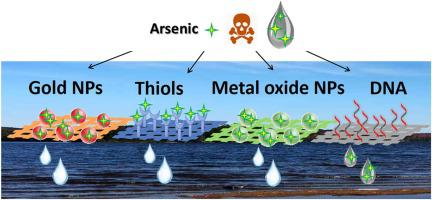Trends in Environmental Analytical Chemistry ( IF 11.1 ) Pub Date : 2021-08-26 , DOI: 10.1016/j.teac.2021.e00143 Chenghua Zong 1, 2 , Xiaoting Jin 1 , Juewen Liu 2

|
Detection of arsenic is a long-standing challenge in environmental analytical chemistry. In recent years, using biomolecules and nanomaterials for sensing arsenic has been growingly reported. In this article, this field is critically reviewed based on some recent fundamental understandings including interactions between arsenic and gold, thiol, and DNA aptamers. First, taking advantage of the adsorption of As(III) on noble metal surfaces such as silver and gold, sensors were developed based on surface enhanced Raman spectroscopy, electrochemistry and colorimetry. In addition, by functionalizing metal nanoparticles with thiol containing molecules, As(III) induced aggregation of the particles based on As(III)/thiol interactions. As(V) interacts with metal oxides strongly and competitive sensors were developed by displacing pre-adsorbed DNA oligonucleotides. A DNA aptamer was selected for As(III) and many sensors were reported based on this aptamer, although careful binding measurements indicated that the sequence has no affinity towards As(III). Overall, bio/nano systems are promising for the detection of arsenic. Future work on fundamental studies, searching for more specific arsenic binding materials and aptamers, incorporation of sensors into portable devices, and more systematic test of sensors in real samples could be interesting and useful research topics.
中文翻译:

用于砷检测的生物/纳米传感器的严格审查
砷的检测是环境分析化学中长期存在的挑战。近年来,使用生物分子和纳米材料检测砷的报道越来越多。在本文中,根据最近的一些基本认识,包括砷与金、硫醇和 DNA 适配体之间的相互作用,对该领域进行了批判性审查。首先,利用 As(III) 在贵金属表面(如银和金)上的吸附,基于表面增强拉曼光谱、电化学和比色法开发了传感器。此外,通过用含硫醇的分子对金属纳米粒子进行功能化,基于 As(III)/硫醇相互作用,As(III) 诱导了粒子的聚集。As(V) 与金属氧化物强烈相互作用,通过取代预先吸附的 DNA 寡核苷酸开发了竞争性传感器。为 As(III) 选择了一个 DNA 适体,并且基于该适体报道了许多传感器,尽管仔细的结合测量表明该序列对 As(III) 没有亲和力。总体而言,生物/纳米系统有望用于检测砷。基础研究的未来工作、寻找更具体的砷结合材料和适体、将传感器结合到便携式设备中以及在实际样品中更系统地测试传感器可能是有趣且有用的研究课题。生物/纳米系统有望用于检测砷。基础研究的未来工作、寻找更具体的砷结合材料和适体、将传感器结合到便携式设备中以及在实际样品中更系统地测试传感器可能是有趣且有用的研究课题。生物/纳米系统有望用于检测砷。基础研究的未来工作、寻找更具体的砷结合材料和适体、将传感器结合到便携式设备中以及在实际样品中更系统地测试传感器可能是有趣且有用的研究课题。











































 京公网安备 11010802027423号
京公网安备 11010802027423号